Lotus root, Indian lotus
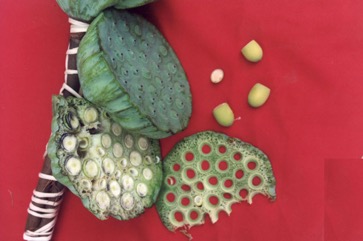
It is a tropical plant but will grow in cooler places. It needs 20-30°C. It needs full sunshine. It can grow in deep water. It does best in fresh water. The pH can range from 5.6-7.5. It grows in wetlands. It is common in some parts of the Philippines such as Laguna de bay. It is also reported from Camarines, Mindoro, Cotabato and Davao. It will probably grow up to about 1000 m altitude. It occurs in the Fly and Sepik River areas in Papua New Guinea. It is cultivated in most of China except the very northern areas. It can grow in arid places. It suits hardiness zones 9-12. In XTBG Yunnan.
Also known as:
Ambal, Ambuj, Ambuja, Aravinda, Baino, Bhen, Bhishi chya biya, Bua-luang, Bua-sai, Bunga padam, Bunga telpok, Chhouk, Chinese lotus, Dhala padma, Dhepra, Erra-tamara, Furong, Hasu, He flower, Hehua, He ye, Indijski lotos, Kalung, Kamal-kakri, Kamal, Kamala, Kankadi, Kanwal, Kokomba, Lian, Lin ngau, Lin, Loto, Lotosblume, Lotus cina, Nelum, Nelumbo, Nelun-ala, Ngau, Padam, Padda, Padda bihar, Padema, Padma, Padon-ma-kya, Padum, Pamposh, Pankaja, Parani baha, Pavan, Pink lotus-lily, Poddo gota,Podum, Purni punp, Renkon, Sacred Lotus lily, Salukid ba, Sen, Senthamara, Seroja, Sivapputamarai, Soh-lapudong, Suriyakamal, Tamburu, Tabare beru, Tavaregadde, Teratai, Thamara, Thamarai, Thambal, Thambou, Thamou, Upal ba, Yavanti, Yeonkkot
Synonyms
- Nelumbo caspica Eichw.
- Nelumbo komarovii Grossheim
- Nelumbo nelumbo (L.) Druce, nom. inval.
- Nelumbo nucifera var. macrorhizomata Nakai
- Nelumbo speciosum Willd., nom. illeg.
- Nelumbium speciosum Willd.
- Nymphaea nelumbo L.
- Nelumbium nelumbo (L.) Druce
Edible Portion
- Seeds, Root, Tuber, Leaves, Stamens, Rhizomes, Seeds - coffee, Vegetable, Fruit, Flowers, Tea
Where does Lotus root grow?
Found in: Africa, Asia, Australia, Azerbaijan, Bangladesh, Bhutan, Cambodia, Caucasus, China, Cuba, East Africa, Dominican Republic, East Timor, Egypt, Guiana, Guianas, Guyana, Haiti, Hawaii, Himalayas, India, Indochina, Indonesia, Iran, Japan, Kenya, Korea, Laos, Madagascar, Malaysia, Micronesia, Myanmar, Nepal, North Africa, North America, Northeastern India, Pacific, Pakistan, Palau, Papua New Guinea, PNG, Philippines, Russia, SE Asia, Slovenia, South America, Sri Lanka, Suriname, Taiwan, Thailand, Timor-Leste, United States, Vietnam, West Indies
Notes: There are 2 Nelumbo species. This one is native to Asia and Australia.
Status: It is a commercially cultivated vegetable. The rhizomes are sold in markets. The stalks are sold in markets. The plant occurs in several coastal areas of Papua New Guinea and the seeds are the part most commonly used for food. It is a sacred plant to Hindus.
Growing Lotus root, Indian lotus
Cultivation: It can be grown from sections of the root or from seed. Seed germinate between 25-30°C. The hard seed coat needs to be cracked to enable seed to grow. Seed will remain viable for many years. Plants grown from seed vary as seed do not breed true. It needs to be in water at least 30-50 cm deep. Rhizomes with 2-3 segments are used. They are put in the mud at a 30° angle.
Edible Uses: The seeds are eaten raw or roasted. Ripe seeds are prepared by removing the seedcoat and the intensely bitter plumule and then boiled in syrup. Slightly unripe seeds are also eaten raw. The seeds can be used as a coffee substitute. The white roots or rhizomes are eaten raw with meat. They can also be boiled, pickled, stir-fried or preserved in sugar. It is also the source of starch. The flower stalks are cooked as a vegetable. They are also eaten raw. The young tender leaves are eaten with a savoury sauce. The dry leaves are used to wrap food and impart flavour. The pollen and stamen are used for flavouring tea.
Production: Plants grow quickly. Rhizomes are harvested all year round and contain an abundance of starch. Plants grown from seed take 2 years to produce. Plants grown from cuttings can produce the same year.
Nutrition Info
per 100g edible portion| Edible Part | Energy (kcal) | Protein (g) | Iron (mg) | Vitamin A (ug) | Vitamin c (mg) | Zinc (mg) | % Water |
|---|---|---|---|---|---|---|---|
| Seed | 130 | 8.8 | 8 | 2 | 3 | 0.2 | 38.8 |
| Root boiled | 66 | 1.6 | 0.9 | 0 | 27.4 | 0.3 | 81.4 |
| Seed dry | 339 | 16.3 | 5.6 | 3 | 0 | 1.1 | 12.7 |
| Seed green | 74 | 4.1 | 1 | 1 | 0 | 0.3 | 80.8 |
Lotus root, Indian lotus Photos

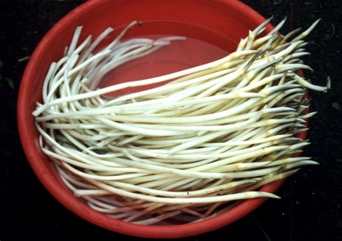
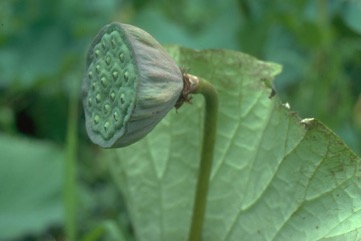
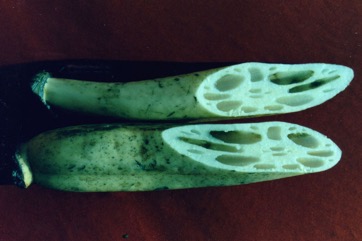
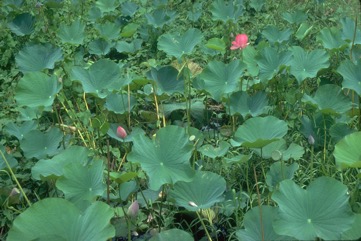
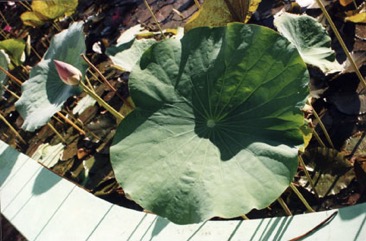
References
Altschul, S.V.R., 1973, Drugs and Foods from Little-known Plants. Notes in Harvard University Herbaria. Harvard Univ. Press. Massachusetts. no. 953 (As Nelumbo speciosa)
Ambasta, S.P. (Ed.), 2000, The Useful Plants of India. CSIR India. p 394
Ara, R. I. T., 2015, Leafy Vegetables in Bangladesh. Photon eBooks. p 155
Arora, R. K., 2014, Diversity in Underutilized Plant Species - An Asia-Pacific Perspective. Bioversity International. p 106
Azam, F. M. S., et al, 2014, Are Famine Food Plants Also Ethnomedicinal Plants? An Ethnomedicinal Appraisal of Famine Food Plants of Two Districts of Bangladesh. Evidence-Based Complementary and Alternative Medicine Volume 2014, Article ID 741712, 28 pages
Bandyopadhyay, S., et al, 2012, A Census of Wild Edible Plants from Howrah District, West Bengal, India. Proceedings of UGC sponsored National Seminar 2012
BARC, 2016, State of Biodiversity for Food and Agriculture in Bangladesh. Bangladesh Agricultural Research Council.
Barrau, J., 1976, Subsistence Agriculture in Polynesia and Micronesia. Bernice P. Bishop Museu, Bulletin 223 Honolulu Hawaii. Kraus reprint. p 55
Bodkin, F., 1991, Encyclopedia Botanica. Cornstalk publishing, p 719
Bourke, M., 1995, Edible Indigenous Nuts in Papua New Guinea. In South Pacific Indigenous Nuts. ACIAR Proceedings No 69, Canberra. p 46
Bremness, L., 1994, Herbs. Collins Eyewitness Handbooks. Harper Collins. p 194
Brock, J., 1993, Native Plants of Northern Australia, Reed. p 264
Brickell, C. (Ed.), 1999, The Royal Horticultural Society A-Z Encyclopedia of Garden Plants. Convent Garden Books. p 697
Brown, W.H., 1920, Wild Food Plants of the Philippines. Bureau of Forestry Bulletin No. 21 Manila. p 56
Burkill, I.H., 1966, A Dictionary of the Economic Products of the Malay Peninsula. Ministry of Agriculture and Cooperatives, Kuala Lumpur, Malaysia. Vol 2 (I-Z) p 1564 (As Nelumbium nelumbo)
Chandrakumar, P., et al, 2015, Ethnobotanical studies of wild edible plants of Gond, Halba and Kawar tribes of Salekasa Taluka, Gondia District, Maharashtra State, India. International Research Journal of Pharmacy 6(8)
Chen, B. & Qiu, Z., Consumer's Attitudes towards Edible Wild Plants, Ishikawa Prefecture, Japan. p 24 www.hindawi.com/journals/ijfr/aip/872413.pdf
Cherikoff V. & Isaacs, J., The Bush Food Handbook. How to gather, grow, process and cook Australian Wild Foods. Ti Tree Press, Australia p 200
Chew, M. & Morgan, W., (Ed.) 1999, Access to Asian Foods Newsletter, Vic Govt., Australia Issue 5
Chin, H. F., 1999, Malaysian Vegetables in Colour. Tropical Press. p 55
Chowdery, T., et al, 2014, Wild edible plants of Uttar Dinajpur District, West Bengal. Life Science Leaflets. 47:pp 20-36 http://lifesciencesleaflets.ning.com
Chowdhury, M. & Mukherjee, R., 2012, Wild Edible Plants Consumed by Local Communities of Maldah of West Bengal, India. Indian J.Sci.Res.3(2) : 163-170
Cribb, A.B. & J.W., 1976, Wild Food in Australia, Fontana. p 98, 124, 179
Cronin, L., 1989, The Concise Australian Flora. Reed. p 102
Cundall, P., (ed.), 2004, Gardening Australia: flora: the gardener's bible. ABC Books. p 922
Deka, N. & Devi, N., 2015, Wild edible aquatic and marshland angiosperms of Baka district, BTC area, Assam, India. Asian J. Plant Sci. Res. 5(1):32-48
Devi, O.S., P. Komor & D. Das, 2010, A checklist of traditional edible bio-resources from Ima markets of Imphal Valley, Manipur, India. Journal of Threatened Taxa 2(11): 1291-1296
Dey, A. & Mukhererjee, A., 2015, Living and Survival Amidst Hunger: Wild Edible Botanicals as a Prime Forest Productivity in the Rural Purulia District, West Bengal, India from Colonial to Present. Research Journal of Forestry 9(3): 71-86
Elliot, W.R., & Jones, D.L., 1997, Encyclopedia of Australian Plants suitable for cultivation. Vol 7. Lothian. p 6
Facciola, S., 1998, Cornucopia 2: a Source Book of Edible Plants. Kampong Publications, p 161
Flora of Pakistan. www.eFloras.org
Foo, J.T.S.(ed), 1996, A Guide to Common Vegetables. Singapore Science Foundation. p 120
French, B.R., 1986, Food Plants of Papua New Guinea, A Compendium. Asia Pacific Science Foundation p 144
Fruct. sem. pl. 1:73, t. 19. fig. 2. 1788
Fu Dezhi, Wiersema J.H., Nelumbonaceae. Flora of China. Vol. 6
Hedrick, U.P., 1919, (Ed.), Sturtevant's edible plants of the world. p 433 (As Nelumbo speciosum)
Heywood, V.H., Brummitt, R.K., Culham, A., and Seberg, O. 2007, Flowering Plant Families of the World. Royal Botanical Gardens, Kew. p 227
Hibbert, M., 2002, The Aussie Plant Finder 2002, Florilegium. p 209
Hiddins, L., 1999, Explore Wild Australia with the Bush Tucker Man. Penguin Books/ABC Books. p 149
Hossain, U. & Rahman, A., 2018, Study and quantitative analysis of wild vegetable floral diversity available in Barisal district, Bangladesh. Asian J. Med. Biol. Res. 2018, 4 (4), 362-371
http://www.botanic-gardens-ljubljana.com/en/plants
Hu, Shiu-ying, 2005, Food Plants of China. The Chinese University Press. p 387
Isaacs, J., 1987, Bush Food, Aboriginal Food and Herbal Medicine. Weldons. p 102
Jabeen, A., et al, 2009, Indigenous uses of economically important flora of Margallah Hills National Park, Islamabad, Pakistan. African Journal of Biotechnology Vol. 8 (5), pp. 763-784
Jacquat, C., 1990, Plants from the Markets of Thailand. D.K. Book House p 35
Jadhav, R., et al, 2015, Forest Foods of Northern Western Ghats: Mode of Consumption, Nutrition and Availability. Asian Agri-History Vol. 19, No. 4: 293-317
Jain et al, 2011, Dietary Use and Conservation Concern of Edible Wetland Plants at Indo-Burma Hotspot: A Case Study from Northeast India. Journal of Ethnobiology and Ethnomedicine 7:29 p 7
Jardin, C., 1970, List of Foods Used In Africa, FAO Nutrition Information Document Series No 2.p 45, 91
Kay, D.E., 1973, Root Crops, Digest 2, Tropical Products Institute, London, p 89
Kays, S. J., and Dias, J. C. S., 1995, Common Names of Commercially Cultivated Vegetables of the World in 15 languages. Economic Botany, Vol. 49, No. 2, pp. 115-152
Kiple, K.F. & Ornelas, K.C., (eds), 2000, The Cambridge World History of Food. CUP p 1804
Konsam, S., et al, 2016, Assessment of wild leafy vegetables traditionally consumed by the ethnic communities of Manipur, northeast India. Journal of Ethnobiology and Ethnomedicine, 12:9
Kumar, G.M., & Shiddamallayya, N., 2014, Documentation of Wild Plant Tubers as Food Resources in Hassan District, Karnataka, International Journal of Applied Biology and Pharmaceutical Technology. 5(2) p 91
Larkcom, J., 1991, Oriental Vegetables, John Murray, London, p 124
Lavelle, M., 2008, Wild Flowers of Australia and Oceania. Southwater. p 109
Lazarides, M. & Hince, B., 1993, Handbook of Economic Plants of Australia, CSIRO. p 169
Leach, G.J., & Osborne, P.L., 1985, Freshwater Plants of Papua New Guinea. UPNG Press, p 194
Leach, G. J., 1988, Bush Food Plants of the Blackwater and Karawari Rivers Area, East Sepik Province, Papua New Guinea. Science in New Guinea 14(2). p 103
Lembaga Biologi Nasional, 1977, Ubi-Ubian, Balai Pustaka, Jakarta. p 96
Li, D. et al, 2017, Ethnobotanical survey of herbal tea plants from the traditional markets in Chaoshan, China. Journal of Ethnopharmacology. 205 (2017) 195-206
Lim, T. K., 2015, Edible Medicinal and Non Medicinal Plants. Volume 9, Modified Stems, Roots, Bulbs. Springer p 57
Liu, Yi-tao, & Long, Chun-Lin, 2002, Studies on Edible Flowers Consumed by Ethnic Groups in Yunnan. Acta Botanica Yunnanica. 24(1):41-56
Llamas, K.A., 2003, Tropical Flowering Plants. Timber Press. p 291
Low, T., 1991, Wild Food Plants of Australia. Australian Nature FieldGuide, Angus & Robertson. p 57
Lyle, S., 2006, Discovering fruit and nuts. Land Links. p 296
Macmillan, H.F. (Revised Barlow, H.S., et al), 1991, Tropical Planting and Gardening. Sixth edition. Malayan Nature Society. Kuala Lumpur. p 356
Manandhar, N.P., 2002, Plants and People of Nepal. Timber Press. Portland, Oregon. p 331
Martin, F.W. & Ruberte, R.M., 1979, Edible Leaves of the Tropics. Antillian College Press, Mayaguez, Puerto Rico. p 208 (As Nelumbium nelumbo)
Massal, E. and Barrau, J., 1973, Food Plants of the South Sea Islands. SPC Technical Paper No 94. Nounea, New Caledonia. p 30
Marwat, S. K., 2011, Medico-ethnobotanical studies of edible wild fruit plants species from the flora of northwestern Pakistan (D. I. Khan district). Journal of Medicinal Plants Research Vol. 5(16) pp 3679-3686
McMakin, P.D., 2000, Flowering Plants of Thailand. A Field Guide. White Lotus. p 84
Menninger, E.A., 1977, Edible Nuts of the World. Horticultural Books. Florida p 110
Mishra, N., et al, 2016, Indigenous knowledge in utilization of wetland plants in Bhadrak district, Odisha, India. Indian Journal of Natural Products and Resources. Vol. 7(1) pp. 82-89
Misra S. & Misra M., 2016, Ethnobotanical and Nutritional Evaluation of Some Edible Fruit Plants of Southern Odisha, India. International Journal of Advances in Agricultural Science and Technology, Vol.3 Issue.1, March- 2016, pg. 1-30
Monsalud, M.R., Tongacan, A.L., Lopez, F.R., & Lagrimas, M.Q., 1966, Edible Wild Plants in Philippine Forests. Philippine Journal of Science. p 511 (As Nelumbium nelumbo)
Morley, B. & Everard, B., 1970, Wild Flowers of the World. Ebury press. Plate 151
Morley, B.D., & Toelken, H.R., (Eds), 1983, Flowering Plants in Australia. Rigby. p 52
Neogi, B., Prasad, M. N. V. and Rao, R. R., 1989, Ethnobotany of Some Weeds of Khasi and Garo Hills, Meghalaya, Northeastern India. Economic Botany 43(4): 471-479
Norrington, L., & Campbell, C., 2001, Tropical Food Gardens. Bloomings Books. p 41
Ochse, J. J. et al, 1931, Vegetables of the Dutch East Indies. Asher reprint. p 542 (As Nelumbium nelumbo)
Ogle, B. M., et al, 2003, Food, Feed or Medicine: The Multiple Functions of Edible Wild Plants in Vietnam. Economic Botany 57(1): 103-117 (As Nelumbium nelumbo)
Omawale, 1973, Guyana's edible plants. Guyana University, Georgetown p 113
Pagag, K. & Borthakur, S.K., 2012, Wild edible wetland plants from Lakhimpur district of Assam, India. Pleione 6(2): 322 - 327
Pasha, M. K. & Uddin, S. B., 2019, Minor Edible Fruits of Bangladesh. Bangladesh J. Plant Taxon. 26(2): 299–313
Patiri, B. & Borah, A., 2007, Wild Edible Plants of Assam. Geethaki Publishers. p 5
Perry, F., and Hay, R., 1982, Guide to Tropical and Subtropical Plants. Sun Books p 102
Pham-Hoang Ho, 1999, An Illustrated Flora of Vietnam. Nha Xuat Ban Tre. p 312
Phon, P., 2000, Plants used in Cambodia. © Pauline Dy Phon, Phnom Penh, Cambodia. p 464
Plants for a Future database, The Field, Penpol, Lostwithiel, Cornwall, PL22 0NG, UK. http://www.scs.leeds.ac.uk/pfaf/
Plants of Haiti Smithsonian Institute http://botany.si.edu/antilles/West Indies (As ssp. lutea)
Plants of Papua New Guinea LAE herbarium record
Polunin, O., & Stainton, A., 2006, Flowers of the Himalaya, Oxford India Paperbacks. p 24
Pradheep, K., et al, 2016, Wild edible plants used by Konyak tribe in Mon district of Nagaland: Survey and inventorisation. Indian Journal of Natural Products and Resources. Vol 7(1) pp 74-81
Rahangdale, D.R. & Rahangdale, S.S., 2014, Potential Wild Edible Plant Resources from Maharashtra Future Prospects for their Conservation and Improvement. Life Science Leaflets. http://lifesciencesleaflets.ning.com
Rajapaksha, U., 1998, Traditional Food Plants in Sri Lanka. HARTI, Sri Lanka. p 342
Recher, P, 2001, Fruit Spirit Botanical Gardens Plant Index. www.nrg.com.au/~recher/ seedlist.html p 3
Reddy, B. M., 2012, Wild edible plants of Chandrapur district, Maharashtra, India. Indian Journal of Natural Products and Resources. 3(1) pp 110-117
Romanowski, N., 2007, Edible Water Gardens. Hyland House. p 28
Royal Botanic Gardens, Kew (1999). Survey of Economic Plants for Arid and Semi-Arid Lands (SEPASAL) database. Published on the Internet; http://www.rbgkew.org.uk/ceb/sepasal/internet [Accessed 4th May 2011]
Sawian, J. T., et al, 2007, Wild edible plants of Meghalaya, North-east India. Natural Product Radiance Vol. 6(5): p 419 (As Nelumbium speciosum)
Schneider, E., 2001, Vegetables from Amaranth to Zucchini: The essential reference. HarperCollins. p 372
Singh, H.B., Arora R.K.,1978, Wild edible Plants of India. Indian Council of Agricultural Research, New Delhi. p14, 31, 83
Scarth-Johnson, V., 2000, National Treasures. Flowering Plants of Cooktown and Northern Australia. Vera Scarth-Johnson Gallery Association. Cooktown, Australia. p 59
Setiya, A. V., et al, 2016, Exploration and documentation of some wild edible plants used by the aboriginals from Gadchiroli District (M.S.) India. International Advanced Research Journal in Science, Engineering and Technology. 3(7)
Singh, S.R. and Singh, N.I., 1985, A Preliminary Ethnobotanical studies on wild edible plants in the markets of Manipur - 1. J. Econ. Tax. Bot. Vol. 6 No. 3 pp 699-703 (As Nelumbium speciosum)
Slocum, P.D. & Robinson, P., 1999, Water Gardening. Water Lilies and Lotuses. Timber Press. p 271
Smith, N. M., 1991, Ethnobotanical Field Notes from the Northern Territory, Australia, J. Adelaide Bot. Gard. 14(1): 1-65
Smith, N., Mori, S.A., et al, 2004, Flowering Plants of the Neotropics. Princeton. p 267
Solomon, C., 2001, Encyclopedia of Asian Food. New Holland. p 223
Song, M., et al, 2013, Traditional knowledge of wild edible plants in Jeju Island, Korea. Indian Journal of Traditional Knowledge. 12(2) pp 177-194
Staples, G.W. and Herbst, D.R., 2005, A tropical Garden Flora. Bishop Museum Press, Honolulu, Hawaii. p 431 (Drawing)
Stephens, K.M., & Dowling, R.M., 2002, Wetland Plants of Queensland. A field guide. CSIRO p 53
Sukarya, D. G., (Ed.) 2013, 3,500 Plant Species of the Botanic Gardens of Indonesia. LIPI p 1151
Swapna, M. M. et al, 2011, A review on the medicinal and edible aspects of aquatic and wetland plants of India. J. Med. Plants Res. 5 (33) pp. 7163-7176
Tanaka, Y & Van Ke, N., 2007, Edible Wild Plants of Vietnam. Orchid Press. p 103
Terra, G.J.A., 1973, Tropical Vegetables. Communication 54e Royal Tropical Institute, Amsterdam, p 63
Thokchom, R., et al, 2016, Documentation and assessment of wild medicinal and edible flowers of valley districts of Manipur. International Journal of Research in Applied, Natural and Social Sciences. 4(11):13-20
Thomson, G. & Morgan, W., (Ed.) 2001, Access to Asian Foods Newsletter, Vic Govt., Australia Issue 8
Townsend, K., 1994, Across the Top. Gardening with Australian Plants in the tropics. Society for Growing Australian Plants, Townsville Branch Inc. p 302
Upreti, K., et al, 2010, Diversity and Distribution of Wild Edible Fruit Plants of Uttarakhand. Bioversity Potentials of the Himalaya. p 174
USDA, ARS, National Genetic Resources Program. Germplasm Resources Information Network - (GRIN). [Online Database] National Germplasm Resources Laboratory, Beltsville, Maryland. Available: www.ars-grin.gov/cgi-bin/npgs/html/econ.pl (10 April 2000)
Valder, P., 1999, The Garden Plants of China. Florilegium. p 229
van Wyk, B., 2005, Food Plants of the World. An illustrated guide. Timber press. p 262
Wickens, G.E., 1995, Edible Nuts. FAO Non-wood forest products. FAO, Rome. p160
Wightman, Glenn et al. 1992, Mangarrayi Ethnobotany: Aboriginal Plant Use from the Elsey Area Northern Australia. Northern Territory Botanical Bulletin No 15. Parks and Wildlife Commission of the Northern Territory. p 36, 35
Woodward, P., 2000, Asian Herbs and Vegetables. Hyland House. p 101
World Checklist of Useful Plant Species 2020. Royal Botanic Gardens, Kew
www.efloras.org Flora of China Volume 6
Yunupinu Banjgul, Laklak Yunupinu-Marika, et al. 1995, Rirratjinu Ethnobotany: Aboriginal Plant Use from Yirrkala, Arnhem Land, Australia. Northern Territory Botanical Bulletin No 21. Parks and Wildlife Commission of the Northern Territory. p 58
Zhang, Y., et al, 2014, Diversity of wetland plants used traditionally in China: a literature review. Journal of Ethnobiology and Ethnomedicine. 10:72